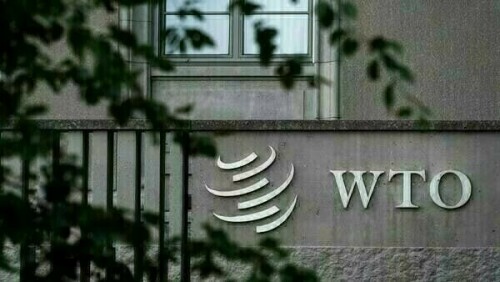WTO Predicts Decline in Global Trade, Cites US Tariffs as Key Factor
GENEVA – The World Trade Organization (WTO) has significantly revised its forecast for global merchandise trade, now anticipating a downturn after previously projecting growth. The organization attributes this shift to escalating U.S. tariffs and their consequential impacts, potentially triggering the most substantial contraction since the peak of the COVID-19 pandemic.
The WTO now projects a 0.2% decrease in goods trade for the current year, a considerable downgrade from its October forecast of a 3.0% increase. This revised estimate accounts for existing trade measures implemented as of the beginning of this week.
“I am deeply concerned about the expected contraction in global merchandise trade growth,” stated WTO Director-General Ngozi Okonjo-Iweala to reporters in Geneva.
The United States, under the leadership of President Donald Trump, has imposed additional tariffs on steel, automobile imports, and broader global tariffs. While the U.S. has paused planned duty increases on certain economies, the trade conflict with China has intensified, with both nations implementing escalating tariffs on each other’s imports.
The WTO indicated that if the U.S. were to reinstate its comprehensive tariffs, it would further diminish goods trade growth by 0.6 percentage points. Additionally, spillover effects beyond U.S.-related trade could cause an additional 0.8 percentage point reduction.
Collectively, these factors could result in a 1.5% decline, representing the most significant contraction since 2020.
“The concern with a contraction in global merchandise is the potential spillover into broader GDP growth. Trade concerns can negatively impact financial markets and other areas of the economy,” Okonjo-Iweala cautioned, also highlighting the potential consequences for developing nations.
The WTO chief expressed particular concern that the economies of China and the U.S. might be separating from each other.
The WTO estimates that merchandise trade between the two nations will plummet by 81%. Without recent exemptions for specific products, such as smartphones, this decline could have reached 91%.
“Decoupling could have profound implications if it contributes to a broader fragmentation of the global economy along geopolitical lines, creating two isolated blocs,” Okonjo-Iweala warned.
In such a scenario, global GDP could contract by 7% in the long term, a figure the Director-General deemed “significant and substantial.”
The WTO acknowledged the unusual nature of current trade policy shifts, advising that forecasts should be viewed with increased caution. The organization projects a modest recovery of 2.5% in 2026.
Hector Torres, a former executive director at the International Monetary Fund, noted that “Forecasting a credible baseline scenario has become virtually impossible.”
“The remnants of a deteriorated ‘rules-based’ trading system are giving way to a capricious ‘deals-based’ disorder, where any projections hinge on government’s capacity to strike bilateral deals,” Torres commented.
Earlier in the week, the UN Trade and Development agency suggested that global economic growth could decelerate to 2.3% due to trade tensions and uncertainty driving a recessionary trend.
The WTO anticipates that disruptions to U.S.-China trade will lead to increased Chinese merchandise exports across all regions except North America by 4% to 9%. Other nations may have opportunities to fill the void in the United States in sectors such as textiles, apparel, and electrical equipment.
Services trade, while not directly subject to tariffs, is also expected to suffer due to reduced demand for goods-related services, such as transport and logistics. Broader uncertainty could also negatively affect spending on travel and investment-related services.
The WTO projects that commercial services trade will expand by 4.0% in 2025 and 4.1% in 2026, below baseline projections of 5.1% and 4.8%. This anticipated slowdown follows a robust 2024, during which the volume of world merchandise trade grew by 2.9% and commercial services trade expanded by 6.8%.



Comments (0)
No comments yet. Be the first to comment!
Leave a Comment